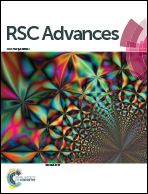Treatment with dibenzoxanthenes inhibits proliferation and induces apoptosis of HepG2 cells via the intrinsic mitochondrial pathway†
Abstract
Dibenzoxanthenes were reported to possess antitumor biological activity. In this study, we synthesized four dibenzoxanthenes analogs (4a–4d) with CN and COOCH3 groups, and revealed the underlying molecular biological mechanism. MTT assay indicated that compounds showed high cytotoxic activities against HepG2, HeLa, SGC-7901 and A549 cells. These compounds also caused DNA damage and G2/M phase arrest in HepG2 cells. Moreover, compounds induced cell apoptosis, which was associated with ROS generation, and a decrease of the mitochondrial membrane potential. Western blotting showed cytochrome c release, caspase-3 and caspase-9 activation, downregulation of Bcl-2, Bcl-xl and upregulation of Bax, Bid. Molecular location experiments showed that compounds 4a–4d entered the nuclei of cells. A cell scratch test and transwell assays indicated that compounds could suppress HepG2 cell migration and invasion. Taken together, our experiment results suggest that the four dibenzoxanthenes (4a–4d) exert their cytotoxicity on HepG2 cells by inducing ROS-mediated mitochondrial dysfunction apoptosis.


 Please wait while we load your content...
Please wait while we load your content...